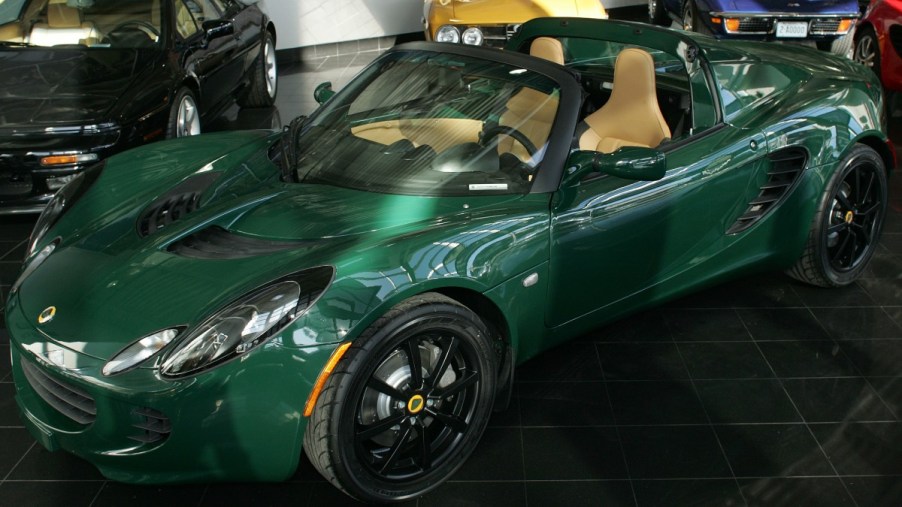
Why Was The Lotus Elise Was So Popular?
The Lotus Elise fit the needs of many drivers. Its small and compact size, performance-focused drive, and supercar good looks made it the choice for more shoppers. More importantly, the Lotus Elise always came with a relatively budget-friendly price. This pint-size performance car quickly made its name as a lightweight and fun-to-drive two-seater. This car became the choice for drivers who wanted excellent track and around-town performance. With the Lotus Elis being no more, it’s only appropriate to look at what made this car so special.
Early year successes
While the Lotus Elise was enjoying early success in the U.K., enthusiasts in the U.S. could only look on jealously. The early iterations of the Lotus Elise were out of this world! Powered by a 1.8-liter Rover K-Series engine, this car could create three different amounts of power, 118 horsepower, 143 horsepower, and 179 horsepower. Those power outputs might not look too impressive, but the driving experience made this small coupe a pleasure to drive with such a low center of gravity and low weight.
The U.S., unfortunately, had to wait until 2005 to finally get a Lotus Elise, but that wait was well worth it.
Supercar looks, economy brand pricing

Once the Lotus Elise finally hit the U.S. market, drivers of all types flocked to it. The 2005 model year marked the introduction to the U.S., but it also marked the beginning of Lotus’ partnership with Toyota.
First of all, in 2005, this exiting coupe started at just under $40,000. While it was by no means cheap, it was attainable. More drivers could see themselves driving one of these models. You could quickly get a coupe that would offer you an outstanding design that can stand out. This performance two-seater looked more like a supercar for many drivers and onlookers.
In addition to the attainable pricing, this also marked the beginning of a long partnership with Toyota. According to Road and Track, this partnership resulted from Arnie Johnson, the Lotus CEO at the time, buying a Toyota Celica GTS, utilizing the powertrain, and building a U.S. legal Lotus Elise.
Continued and valued progression

As U.S. drivers were finally enjoying the Lotus Elise behind the scenes, Lotus was working hard to ensure that the new iterations were ready to impress. For the Series 3 models introduced in 2010, drivers immediately noticed that the looks were remarkably similar. In other cars, that could be a bad thing, but with a Lotus Elise, it was essential to its success. The new Series 3 models used a 1.8-liter four-cylinder engine sourced from Toyota, with an added supercharger for an extra kick. The first years of this generation, or Series, were continued success for Lotus, with the first extensive upgrades coming in 2015. At the 2015 Geneva Motorshow, Lotus unveiled the new, track-focused Cup 220 model. This new model uses the same 1.8-liter supercharged four-cylinder engine as the regular models but can easily handle the track.
A turn toward big performance

The Series 3 models were some of the most exciting sports cars around when they were new. Every year Lotus made considerable strides to offer unique and sporty cars. The following big models that hit the market were the Sport and Sport 220. These two models replaced the Lotus Elise and S model.
Not long after introducing these two models, Lotus made the jump to offering higher performance models. Models like the Lotus Elise Cup 250 and Lotus Elise Cup 260 offered drivers the chance to get a more exciting drive. These two models both utilized the same 1.8-liter supercharged four-cylinder engine, with ease making more power. The Cup 250 model produced 243 horsepower, while the Elise Cup 260 created 250 horsepower.
These unique two-seater models would utilize this power to bring you a driving experienced unmatched by the competition.
Final editions bring the Lotus Elise to a spectacular end
In 2021, Lotus announced that the Lotus Elise would be coming to an end. To mark this big announcement, Lotus also announced that there would be two final models, the Sport 240 Final Edition and the Cup 250 Final Edition. These two models had an abundance of upgrades that made each model even more special.
Drivers who could get their hands on a Sport 240 Final Edition could enjoy an upgraded engine. But more importantly, this model benefits from some significant weight savings. Finally, the Lotus Elise Cup 250 Final Edition took many of the aspects of the above model and added more power and more weight savings.
With the departure of the Lotus Elise, drivers will surely miss this unique and fun-to-drive two-seater. At the start, this sports car was a budget-friendly option, and even as the years went on, this two-door continued to be a relatively affordable sports car.
The Lotus Elise is a memorable car

The Lotus Elise was a favorite among drivers because of its small size, outstanding driving experience, and unique styling. With a surprisingly affordable price point, the this pint-sized two-seater will undoubtedly be missed.
Lotus continues to produce some great new sports cars, including an all-new upcoming Lotus Emira and even an SUV, the Lotus Eletre.


